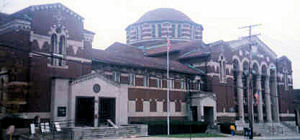|
See the route
from
home to "shul" and their
1930 census record
(lines 10-13).
The sanctuary was designed Sephardic style, with the bimah
for the service leader near the center of the main floor. Women would be seated
in the balcony. The congregation would hire its first rabbi in 1931.
Probably only Yiddish would
be spoken, with prayers in
Hebrew. We believe Yiddish
was used for years, for in the congregation's archives at the Western Reserve
Historical Society is a minute
book for 1941 - 1945,
written in Yiddish. (For
other Glenville synagogues,
click here.)
In 1957 the congregation would move to
Warrensville Center Road in
Cleveland Heights to form
Warrensville
Center Synagogue also
known as Kehillat Yaakov.
It has just moved to a new
building on Cedar Road near
Green Road. For the history
of this synagogue, the core
of which was the Tetiever
shul,
click here.
The Linn
Drive building, shown above
in a recent photo, is now
owned by the True Vine
Baptist Church.
Klausner Cooperage
In his home town, Sam had been a cooper - he made wooden barrels. He had a
barrel-making business in the yard of his house, taught
his older sons the trade and also employed others. In
Cleveland Sam and his sons Nathan and Ben peddled used
barrels. Then, some time before 1920, they formed
Klausner Cooperage to manufacture barrels. It would soon
employ son Jake, for a while son-in-law Issie Klotzman,
and other relatives. With the
leadership of the Klausner sons Ben, Nathan and Jake the business grew
quickly - it was an American success story.
For more on the family's main business
enterprise, see Klausner
Cooperage.
Moving to Glenville,
then the Heights
|
Around 1925 Sam and
Minnie moved from their
home on East
51st near
Woodland
to this house on Phillips
Avenue in
Glenville, the
city's
newest,
largest Jewish neighborhood.
They probably
bought their
home soon after
the "shul"
decided to build
on Linn Drive.
Their youngest
daughter Rose
would graduate
from
Glenville High
School and then
earn a degree
from Western
Reserve
University.
In 1936 Sam and
Minnie moved to
Silsby Road in
the inner-ring
suburb of Cleveland
Heights.
Minnie's oldest
son Beryl
Linetzky and his
family lived in the Phillips Avenue
house until 1947. |
|
 |
|
Ruth Abelson,
one of Ben
Klausner's
daughters,
writes:
|
I
have
a
vivid
recollection...of
my
twin
sister
and
I
coming
to
play
"trick
or
treat"
on
Halloween
on
Grandpa
and
Grandma
Klausner
on
Silsby
Road
and
being
doused
with
water
from
a
hose
by
my
grandpa
because
he
did
not
recognize
us
and
was
tired
of
"trick
or
treaters"
by
the
time
we
showed
up
(in
costume).
When
we
finally
succeeded
in
making
it
clear
that
we
were
his
twin
granddaughters,
he
turned
off
the
hose
and
hugged
us
dry.
The
walk
from
Tullamore
Road
to
Silsby
was
quite
a
long walk
for
us.
|
Bea Gray,
one of
Nathan
Klausner's
four
daughters,
writes:
| Every Sunday morning, Nathan, Ben, Jake and probably Abe and Harry all went to their parents house, with their children, not the babies, just us kids. The adults would talk business, of course, and all the kids got to play with all their first cousins. None of the wives were present. Then around noon all the wives would call the husbands to come home for lunch. This started when the folks lived on Phillips Avenue and continued even when they moved to Silsby. |
Changing
synagogues
|

Temple
on
the
Heights
(B'nai
Jeshurun) |
|
During
the
first
half
of
the
20th
century
many
Jewish
immigrants
and
their
children
found
their
Orthodox
congregations
too
restrictive.
(Separate
seating
of
men
and
women
was
often a
major
objection.)
They
also
saw
Reform,
then
in a
period
known
as
Classical
Reform,
too
unfamiliar.
By
1950
Conservative
Judaism
would
be
the
largest
form
of
organized
American
Judaism. |
|
By
the 1920's, B'nai
Jeshurun,
which
had been started
in
1866
by
Hungarian
Jews
and
was originally
Orthodox,
had become
a
Conservative
congregation
and
was no
longer
seen
as
the
Hungarian
shul.
In 1926,
when
it
moved
to "Temple
on
the
Heights",
on
Mayfield
Road
east
of
Lee
Road,
it became the
first
Conservative
synagogue to
build in the
Heights and
perhaps the
nation's largest
Conservative
synagogue.
More on B'nai
Jeshurun.
As
the
Klausner
sons
moved
to
the
Heights,
even
before
their
children
reached
school
age,
they
would
leave
the
Orthodox Tetiever
congregation.
Son
Nathan,
an
admirer
of
Rabbi
Abba
Hillel
Silver,
joined
the The
Temple
-
Tifereth
Israel
(Reform).
Sam's
other children,
including Ben, Jake, Abe,
Harry and Rose,
would join
Conservative B'nai Jeshurun.
Only
Minnie's
son
Beryl,
who
died
while
still
living
in
Glenville
and
is
buried
in
the
Tetiever
cemetery,
and son-in-law
Issie
Klotzman,
who
owned
a
Kosher
butcher
shop,
would
remain
Orthodox.
When
Sam
and
Minnie
left
Glenville
for
Cleveland
Heights
in
1936,
Sam
may
have attended B'nai Jeshurun
from
time
to
time,
but
he maintained
his
connection
to
the
old
Tetiever
synagogue,
in
whose
cemetery
section
Minnie,
and then
Sam,
would
be
buried. |
|
|